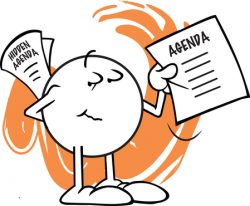 Effective Chama meetings allow for open conversation that draws upon each members’ knowledge, skills, and perspectives to solve problems and to support one another in achieving the team’s collective goals.
Effective Chama meetings allow for open conversation that draws upon each members’ knowledge, skills, and perspectives to solve problems and to support one another in achieving the team’s collective goals.
Effective meetings are not only integral to achieve team goals and successful completion of tasks, but also are reflective overall of team functioning
There are many reasons why meetings are not effective, some of these include:
The meeting lacks clarity of purpose
A meeting must have a specific and defined purpose. Before you send that calendar invite, ask yourself: What do I seek to accomplish? Are you alerting people to a change in leadership or a shift in strategy?
Are you seeking input from others on a problem facing the group? Are you looking to arrive at a decision on a particular matter?
Starting meetings with vague purposes, such as “status updates,” are rarely a good use of time.
Inappropriate style of leadership
When discussion is underway, it is the chairperson’s responsibility to ensure that it continues to flow smoothly by involving all members present and by not permitting one or two people to dominate the meeting. Summarizing by the chairperson during meetings can:
1. Indicate progress, or lack of.
2. Refocus discussion that has wandered off the point.
3. Conclude one point and lead into the next.
4. Highlight important points.
5. Assist the secretary if necessary.
6. Clarify any misunderstanding.
The chairperson should pace the meeting, ensuring it runs to time. If the planning has been properly executed, this should not prove to be a problem. The chairperson exercises little control and allows one or two members to dominate the proceedings.
Flow of discussion and members contribution
1. Decisions emerge that are not truly representative.
2. Problems are talked about rather than being talked through.
3. Decisions are delayed or not acted upon.
4. No clear-cut decisions are made.
Minutes are inaccurate
Minutes record the decisions of the meeting and the actions for follow-up.
Minutes are a visible means of measuring and monitoring whether individuals assigned to tasks have completed those tasks.
They serve as a reminder for all to track whether tasks have been finished by those with designated responsibilities.
Thus one group member needs to be assigned to handle this task. Each new meeting there needs to be a brief re-cap on the previous meetings minutes to ensure accuracy and also follow-up.
Technology
The reality is that if people are allowed to bring phones or laptops into the room, they won’t be focusing on the meeting or contributing to it.Instead, they’ll be emailing, surfing the web, or just playing around with their technology.
Time
If you have responsibility for running regular meetings and you have a reputation for being someone who starts and ends promptly, you will be amazed how many of your team members will make every effort to attend your meetings. People appreciate it when you understand that their time is valuable.
The skills of managing team meetings are fundamental to productive teamwork and usually easy to learn and simple to adopt.
The way to a well-facilitated meeting that promotes open communication, creativity, and consensus-building among its members.
Categorised in: General
This post was written by
Please Subscribe and get Notified when new articles are posted
